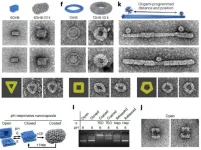(Press-News.org) As the world's population continues to grow, ensuring access to clean and safe water has become an increasingly important concern, yet little is known about how surface water quality will change in the future. Recent scientific research has shed light on the potential challenges that surface water quality may face in the coming years, particularly in Sub-Saharan Africa. “While surface water quality is projected to improve in most developed countries, there is an important caveat: the outlook for the poorest nations is bleak”.
A recent study, published in Nature Water, has projected an increase in surface water pollution in Sub-Saharan Africa. These findings highlight the need for proactive measures to protect surface water resources and safeguard the well-being of communities. The study, led by Utrecht University researcher Edward Jones, emphasizes the importance of equitable and sustainable development, particularly in regions expected to experience the greatest challenges. Using a new global model, he assessed how climate change and societal developments could impact surface water quality until the end of the century.
Key hotspot
“Irrespective of climate change and socio-economic scenario, there will be a strong increase in the number of people living in Sub-Saharan Africa who are exposed to poor surface water quality”, warns Jones. “This pattern is not systematically replicated in any other world region.” Even under the most optimistic future scenario the number of people exposed to pollutant concentrations exceedances in Sub-Saharan Africa will more than double. Alternatively, under pessimistic assumptions, the number of people exposed to poor surface water quality can increase 5-fold. “With the combination of strong water quality degradation and the drastic increases in the number of people exposed to poor surface water quality, our paper concludes that Sub-Saharan Africa will become the key hotspot of surface water pollution in the future.”
Challenges
The challenges are multifold, according to Jones. Waterborne diseases caused by pathogen-contaminated water can pose a significant risk to human populations. With a growing global population, the availability of good quality water for irrigation is of utmost importance. Additionally, energy production, which is key for global development, can be hampered by a combination of both low water levels and high water temperatures. Thus, the study highlights the importance of limiting both climate change and anthropogenic water pollution to safeguard both human livelihoods and ecosystem health in the future.
Article
Edward R. Jones, Marc F.P. Bierkens, Peter J.T.M. van Puijenbroek (...), Michelle T.H. van Vliet, ‘Sub-Saharan Africa will increasingly become the dominant hotspot of surface water pollution’, Nature Water, https://doi.org/10.1038/s44221-023-00105-5 (after lift of embargo)
END
Addressing the future challenges of global surface water quality
Sub-Saharan Africa as the key future hotspot
2023-07-17
ELSE PRESS RELEASES FROM THIS DATE:
Study finds how to reduce risk of kids playing with a found gun
2023-07-17
COLUMBUS, Ohio – In a lab at The Ohio State University masquerading as a playroom, pairs of kids ages 8 to 12 participating in a study found a variety of toys and games to play with – as well as a mysterious file cabinet.
Inside one of the drawers of the unlocked cabinet were two disabled 9-mm handguns.
As they played in the room, nearly all the children eventually found the guns. But some kids in the study were much more likely to tell an adult they found a gun, less likely to touch the gun, and were less reckless if they did touch it – and they were the kids who had watched a one-minute gun safety video a week earlier.
The study may be the ...
Trading sickness for health: Swapping brain cells points to new Huntington's therapies
2023-07-17
NNew research appearing in the journal Nature Biotechnology answers important questions about the viability of treatments that seek to replace diseased and aged cells in the central nervous system with healthy ones. Its findings have implications for a number of neurological and psychiatric disorders—including Huntington’s disease, amyotrophic lateral sclerosis (ALS), and schizophrenia—that have been linked to glia, a population of cells that support brain health and function.
“A broad variety of disorders we associate with neuronal loss now appear to be caused ...
Researchers craft ‘origami DNA’ to control virus assembly
2023-07-17
Griffith University researchers have played a key role in using DNA ‘origami’ templates to control the way viruses are assembled.
The global team behind the research, published in Nature Nanotechnology, developed a way to direct the assembly of virus capsids – the protein shell of viruses - at physiological conditions in a precise and programmable manner.
Dr Frank Sainsbury and Dr Donna McNeale from the Griffith Institute for Drug Discovery were part of the research team and said forcing viruses to assemble onto DNA folded into different shapes “like origami” was a question that this project answered.
“We achieved control over the virus protein ...
Cap top 20% of energy users to reduce carbon emissions
2023-07-17
Consumers in the richer, developed nations will have to accept restrictions on their energy use if international climate change targets are to be met, warn researchers.
The big challenge is to identify the fairest and most equitable way that governments can curtail energy use, a process known as energy demand reduction.
Writing in the journal Nature Energy, the research team - led by Milena Büchs, Professor of Sustainable Welfare at the University of Leeds - analysed several scenarios to identify a potential ...
Excess mortality with Alzheimer disease and related dementias as an underlying or contributing cause during pandemic
2023-07-17
About The Study: This study found that large increases in mortality with Alzheimer disease and related dementias as an underlying or contributing cause of death occurred in COVID-19 pandemic year 1 but were largely mitigated in pandemic year 2. The most pronounced declines were observed for deaths in nursing home/long-term care settings. Conversely, excess deaths at home and in medical facilities remained high in year 2.
Authors: M. Maria Glymour, Sc.D., of the Boston University School of Public Health ...
Comparison of history of present illness summaries generated by a chatbot and senior internal medicine residents
2023-07-17
About The Study: History of present illnesses generated by a chatbot or written by senior internal medicine residents were graded similarly by internal medicine attending physicians. These findings underscore the potential of chatbots to aid clinicians with medical documentation.
Authors: Ashwin Nayak, M.D., M.S., of Stanford University in Stanford, California, is the corresponding author.
To access the embargoed study: Visit our For The Media website at this link https://media.jamanetwork.com/
(doi:10.1001/jamainternmed.2023.2561)
Editor’s Note: Please see the article for additional information, including other authors, author contributions and affiliations, ...
Addressing adaptation inequalities in climate research
2023-07-17
A new study proposes ways to better incorporate adaptation in climate change research, addressing the uneven distribution of adaptation capacities and needs worldwide.
Research on adaptation to the risks posed by climate change has witnessed significant growth in the past decade, with increasing recognition of its urgency in policy agendas at the international, national, and local levels. Adaptation needs and capacities are not evenly distributed worldwide, with countries in the Global South generally experiencing the highest challenges. ...
Heading frequency and risk of cognitive impairment in retired male professional soccer players
2023-07-17
About The Study: The findings of this study suggest that repetitive heading during a professional soccer career is associated with an increased risk of cognitive impairment in later life. Further study is needed to establish the upper threshold for heading frequency to mitigate this risk.
Authors: Weiya Zhang, Ph.D., of the University of Nottingham in Nottingham, United Kingdom, is the corresponding author.
To access the embargoed study: Visit our For The Media website at this link https://media.jamanetwork.com/
(doi:10.1001/jamanetworkopen.2023.23822)
Editor’s Note: Please ...
COVID-19 vaccines saved dementia patients' lives in nursing homes
2023-07-17
Deaths among older adults with dementia fell starkly in nursing homes and long-term care centers after COVID-19 vaccinations became available, yet remained high for those living at home, according to a new study led by UC San Francisco.
The nationwide study published July 17, 2023 in JAMA Neurology, is the first to use data from 2019 to 2022 to quantify “excess” deaths – or those above what would have been anticipated had there been no pandemic – taking into account age, sex, racial and ethnic groups, as well as the settings where people died.
In the first year, there were 509,179 dementia-related ...
Reprogramming the shape of virus capsids could advance biomedicine
2023-07-17
Bioengineers have found a way to program the size and shape of virus particles by combining viral protein building blocks and templates made from DNA. The resulting nanostructures could have applications in vaccine development and transporting drugs inside the body.
Virus capsid proteins—the proteins that shield the genome of a virus—can be used to build precisely structured protein assemblies. Their shapes and geometry, however, depend largely on the virus strain. Reprogramming these assemblies, no matter the original ...
LAST 30 PRESS RELEASES:
The impact of family dynamics on eating behaviour – how going home for Christmas can change how you eat
Tracing the quick synthesis of an industrially important catalyst
New software sheds light on cancer’s hidden genetic networks
UT Health San Antonio awarded $3 million in CPRIT grants to bolster cancer research and prevention efforts in South Texas
Third symposium spotlights global challenge of new contaminants in China’s fight against pollution
From straw to soil harmony: International team reveals how biochar supercharges carbon-smart farming
Myeloma: How AI is redrawing the map of cancer care
Manhattan E. Charurat, Ph.D., MHS invested as the Homer and Martha Gudelsky Distinguished Professor in Medicine at the University of Maryland School of Medicine
Insilico Medicine’s Pharma.AI Q4 Winter Launch Recap: Revolutionizing drug discovery with cutting-edge AI innovations, accelerating the path to pharmaceutical superintelligence
Nanoplastics have diet-dependent impacts on digestive system health
Brain neuron death occurs throughout life and increases with age, a natural human protein drug may halt neuron death in Alzheimer’s disease
SPIE and CLP announce the recipients of the 2025 Advanced Photonics Young Innovator Award
Lessons from the Caldor Fire’s Christmas Valley ‘Miracle’
Ant societies rose by trading individual protection for collective power
Research reveals how ancient viral DNA shapes early embryonic development
A molecular gatekeeper that controls protein synthesis
New ‘cloaking device’ concept to shield sensitive tech from magnetic fields
Researchers show impact of mountain building and climate change on alpine biodiversity
Study models the transition from Neanderthals to modern humans in Europe
University of Phoenix College of Doctoral Studies releases white paper on AI-driven skilling to reduce burnout and restore worker autonomy
AIs fail at the game of visual “telephone”
The levers for a sustainable food system
Potential changes in US homelessness by ending federal support for housing first programs
Vulnerability of large language models to prompt injection when providing medical advice
Researchers develop new system for high-energy-density, long-life, multi-electron transfer bromine-based flow batteries
Ending federal support for housing first programs could increase U.S. homelessness by 5% in one year, new JAMA study finds
New research uncovers molecular ‘safety switch’ shielding cancers from immune attack
Bacteria resisting viral infection can still sink carbon to ocean floor
Younger biological age may increase depression risk in older women during COVID-19
Bharat Innovates 2026 National Basecamp Showcases India’s Most Promising Deep-Tech Ventures
[Press-News.org] Addressing the future challenges of global surface water qualitySub-Saharan Africa as the key future hotspot

